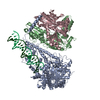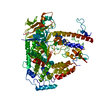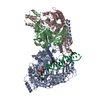+Search query
-Structure paper
| Title | Coordinated DNA polymerization by Polγ and the region of LonP1 regulated proteolysis. |
|---|---|
| Journal, issue, pages | Nucleic Acids Res, Vol. 52, Issue 13, Page 7863-7875, Year 2024 |
| Publish date | Jul 22, 2024 |
 Authors Authors | Amanda A Riccio / Asia J Brannon / Juno M Krahn / Jonathan Bouvette / Jason G Williams / Mario J Borgnia / William C Copeland /  |
| PubMed Abstract | The replicative mitochondrial DNA polymerase, Polγ, and its protein regulation are essential for the integrity of the mitochondrial genome. The intricacies of Polγ regulation and its interactions ...The replicative mitochondrial DNA polymerase, Polγ, and its protein regulation are essential for the integrity of the mitochondrial genome. The intricacies of Polγ regulation and its interactions with regulatory proteins, which are essential for fine-tuning polymerase function, remain poorly understood. Misregulation of the Polγ heterotrimer, consisting of (i) PolG, the polymerase catalytic subunit and (ii) PolG2, the accessory subunit, ultimately results in mitochondrial diseases. Here, we used single particle cryo-electron microscopy to resolve the structure of PolG in its apoprotein state and we captured Polγ at three intermediates within the catalytic cycle: DNA bound, engaged, and an active polymerization state. Chemical crosslinking mass spectrometry, and site-directed mutagenesis uncovered the region of LonP1 engagement of PolG, which promoted proteolysis and regulation of PolG protein levels. PolG2 clinical variants, which disrupted a stable Polγ complex, led to enhanced LonP1-mediated PolG degradation. Overall, this insight into Polγ aids in an understanding of mitochondrial DNA replication and characterizes how machinery of the replication fork may be targeted for proteolytic degradation when improperly functioning. |
 External links External links |  Nucleic Acids Res / Nucleic Acids Res /  PubMed:38932681 / PubMed:38932681 /  PubMed Central PubMed Central |
| Methods | EM (single particle) |
| Resolution | 3.0 - 4.2 Å |
| Structure data | EMDB-42979, PDB-8v54: EMDB-42980, PDB-8v55: EMDB-42982, PDB-8v5d: EMDB-42984, PDB-8v5r: |
| Chemicals |  ChemComp-MG:  ChemComp-D3T: |
| Source |
|
 Keywords Keywords | DNA BINDING PROTEIN/DNA / Mitochondria DNA polymerase / DNA polymerase gamma / Mitochondrial DNA replication / DNA binding protein / DNA BINDING PROTEIN-DNA complex / DNA polymerase / DNA polymerase catalytic subunit |
 Movie
Movie Controller
Controller Structure viewers
Structure viewers About Yorodumi Papers
About Yorodumi Papers











 homo sapiens (human)
homo sapiens (human)